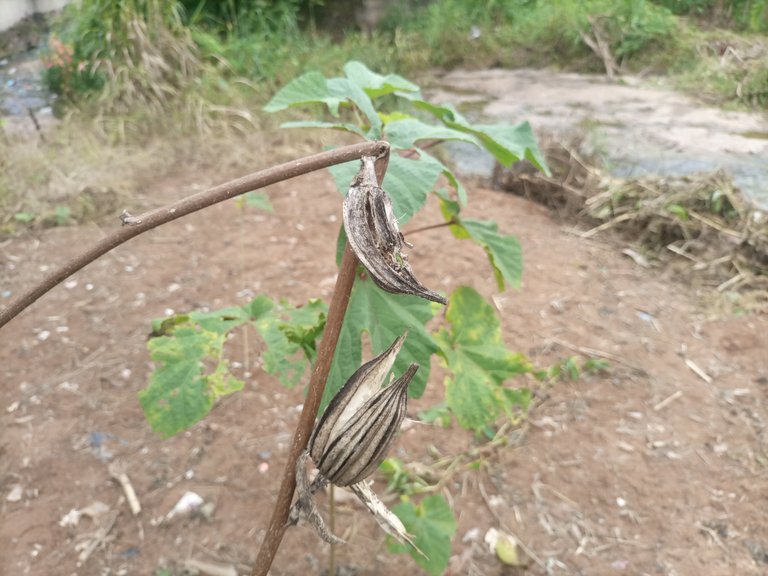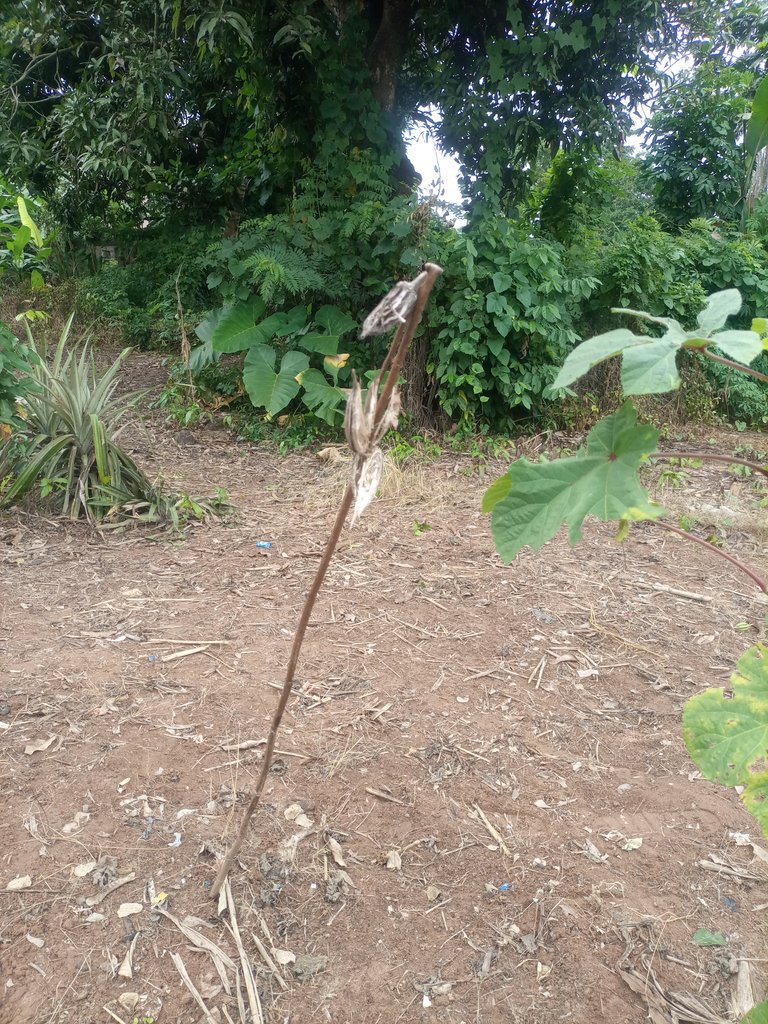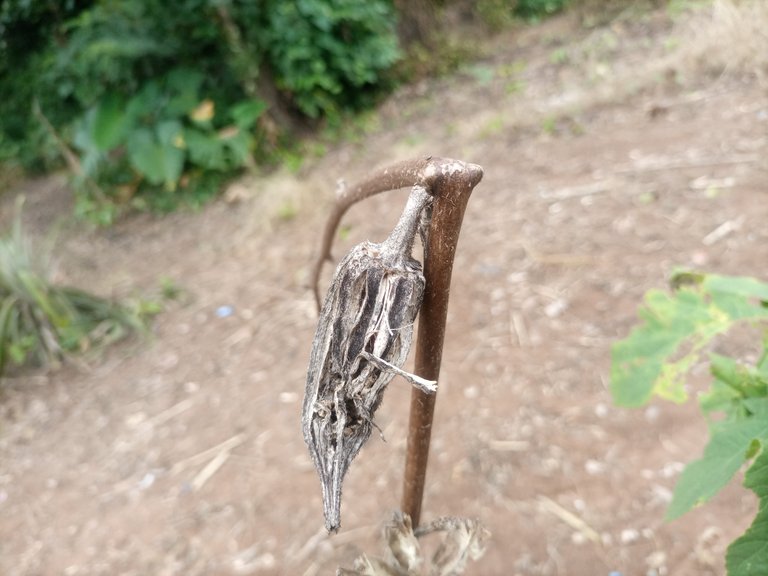Okra is among popular vegetables that's very common and cheap to afford in Nigeria. The way farmers farm okra almost every season will make anyone believe Okra is acceptable and used for cooking of soup. I and my family loves eating Okra soup because of its draw content, taste, and cheapness to afford in the market. Okra fruit or seed is what we use for soup cooking, it's green in color.

Okra is not only enjoyed in soup but also as source for eating of yam, cocoyam, potatoes, and more. Presently in Nigeria, almost every household now cook Okra soup because it's very cheap to afford in the market compared to other vegetables. Most times, I'll love to cook soup but there'll be no much money in the house for me to use and buy ingredients. Instead me going for higher vegetables which will end up consuming much money for ingredients, I'll rather buy Okra at cheap price.

Something good about Okra is that it can be prepared and be eating without adding any ingredients to it as soup or source. Unlike other vegetables that one will have to add meat, fish, and other ingredients before the taste of the soup will surface.

Okra in Planting
In terms of planting, Okra is among crops that can put smile to the face of a farmer. Anytime I'm making ways to plant Okra, I usually smile because I know there's no way I'll not be harvesting something big. Okra is a crop that can be planted and harvested within a short period of time. Challenge I usually face after planting Okra is during the planting day and newly germination period. When planted newly, squirrel 🐿️, birds, and others may eat them up. So, all I do is to protect them.
The speed which Okra can grow after planting is very encouraging to farmers. A farmer can keep harvesting Okra for a very long period.

Reservation of Okra for replanting
There are different methods at which farmers use to reserve Okra before planting them. The one I know is what I'll share and I think it should be the best for everyone.
If a farmer wishes to get the best for Okra planting, the farmer will have to ensure she has already mature Okra. The Okra must be free from pest and other harmful elements. The farmer will have to harvest the Okra one or two rimes. After the harvest, the farmer will have to allow the Okra to keep growing and producing a lot of Okra fruit or seed. The farmer don't need to harvest the Okra but to allow them grow very old together with the Okra stem, and leaf.
By the time the Okra grows old, the color will change from green to brown. That will show the farmer the Okra is due. The farmer will now harvest the Okra seed and then reserve them till when to be use for planting.
Spanish Language Translation
La okra es una de las verduras populares más comunes y baratas en Nigeria. La forma en que los agricultores cultivan la okra casi cada temporada hace creer a cualquiera que la okra es aceptable y se utiliza para cocinar sopa. A mi familia y a mí nos encanta tomar sopa de okra por su contenido en calorías, su sabor y lo barata que resulta en el mercado. El fruto o la semilla de la okra, de color verde, es lo que utilizamos para cocinar la sopa.

La okra no sólo se disfruta en la sopa, sino también como fuente para comer ñame, cocoyam, patatas y mucho más. Actualmente, en Nigeria, casi todos los hogares cocinan sopa de okra porque es muy barata en el mercado en comparación con otras verduras. La mayoría de las veces, me encanta cocinar sopa, pero no tengo mucho dinero en casa para comprar los ingredientes. En lugar de comprar verduras más caras, que me costarían mucho dinero, prefiero comprar Okra a bajo precio.

Algo bueno de la Okra es que se puede preparar y comer sin añadirle ningún ingrediente como sopa o fuente. A diferencia de otras verduras a las que habrá que añadir carne, pescado y otros ingredientes antes de que aflore el sabor de la sopa.

Okra en plantación
En términos de plantación, la Okra se encuentra entre los cultivos que pueden poner una sonrisa en la cara de un agricultor. Cada vez que me pongo a plantar Okra, suelo sonreír porque sé que es imposible que no coseche algo grande. La okra es un cultivo que se puede plantar y cosechar en poco tiempo. El reto al que suelo enfrentarme después de plantar Okra es durante el día de la plantación y el periodo de nueva germinación. Cuando está recién plantada, la ardilla 🐿️, los pájaros y otros pueden comérsela. Así que lo único que hago es protegerlas.
La velocidad a la que puede crecer la Okra después de plantarla es muy alentadora para los agricultores. Un agricultor puede seguir cosechando Okra durante un periodo muy largo.

Reserva de Okra para replantación
Existen diferentes métodos que utilizan los agricultores para reservar la Okra antes de plantarla. El que yo conozco es el que voy a compartir y creo que debería ser el mejor para todos.
Si un agricultor desea obtener lo mejor para plantar Okra, tendrá que asegurarse de que dispone de Okra ya madura. La Okra debe estar libre de plagas y otros elementos nocivos. El agricultor tendrá que cosechar la Okra una o dos veces. Después de la cosecha, el agricultor tendrá que dejar que la Okra siga creciendo y produciendo muchos frutos o semillas de Okra. El agricultor no tiene que cosechar la okra, sino dejar que crezca junto con el tallo y las hojas.
Cuando la okra envejezca, su color cambiará de verde a marrón. Esto indicará al agricultor que la okra está madura. El agricultor cosechará las semillas de okra y las reservará hasta el momento de plantarlas.
Very interesting what you tell us friend. I really didn't know that plant. Or at least not by that name.
I personally like nature and agriculture very much, so it was a pleasure to learn about the methods of cultivation in your country. And especially the importance it has for feeding the population.
Thanks for bringing us such a detailed post. A pleasure to read you. Have a nice day. Regards
Okra is known as lady's Fingers in English language and it's used for soup cooking. It draws like like gum when prepared and in progress for eating.